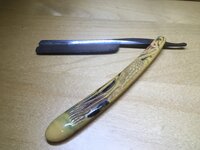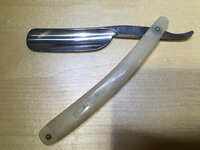Hi All,
Seeking advice on how to do a better job of polishing a blade. The subject in this case is a JR Torrey Our 136. When purchased it was covered with black spots. I was hoping to avoid erasing the etching (unlike my last restoration) so I carefully taped over the “Our 136” and proceeded to sand away. I started with W/D sandpaper (used wet) and then progressed to diamond paste on a Dremel. The specific progression was:
1000, 1200, 1500, 2000, 2500, 3000, 1u on felt disc, 0.5u on felt disc, 0.5u on buffer, 0.25u on felt disc, 0.25u on buffer. When finished you could still clearly see a difference in reflective quality between the clean and taped areas. I’ve been told that 0.25u is at the range of visible light, so I‘m assuming the issue is too big a progression or perhaps not enough time at one level. In particular perhaps the jump from 3000 grit W/D to 1u diamond paste on a Dremel felt disk is the issue. Suggestions of what to do differently? And yes I know that there is also the issue of the patina on the on-cleaned area.
Photos below
1. As purchased (the black spots don’t show up in their true glory)
2. Taped an cleaning started
3. At end of 1200
4. At end of 2000
5. After all cleaning, tightening the pivot pin and honing.
Thanks in advance!
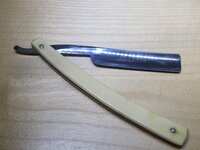
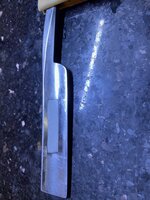
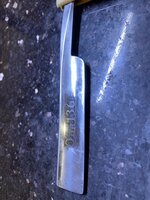
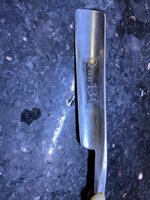
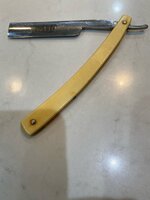
Seeking advice on how to do a better job of polishing a blade. The subject in this case is a JR Torrey Our 136. When purchased it was covered with black spots. I was hoping to avoid erasing the etching (unlike my last restoration) so I carefully taped over the “Our 136” and proceeded to sand away. I started with W/D sandpaper (used wet) and then progressed to diamond paste on a Dremel. The specific progression was:
1000, 1200, 1500, 2000, 2500, 3000, 1u on felt disc, 0.5u on felt disc, 0.5u on buffer, 0.25u on felt disc, 0.25u on buffer. When finished you could still clearly see a difference in reflective quality between the clean and taped areas. I’ve been told that 0.25u is at the range of visible light, so I‘m assuming the issue is too big a progression or perhaps not enough time at one level. In particular perhaps the jump from 3000 grit W/D to 1u diamond paste on a Dremel felt disk is the issue. Suggestions of what to do differently? And yes I know that there is also the issue of the patina on the on-cleaned area.
Photos below
1. As purchased (the black spots don’t show up in their true glory)
2. Taped an cleaning started
3. At end of 1200
4. At end of 2000
5. After all cleaning, tightening the pivot pin and honing.
Thanks in advance!








